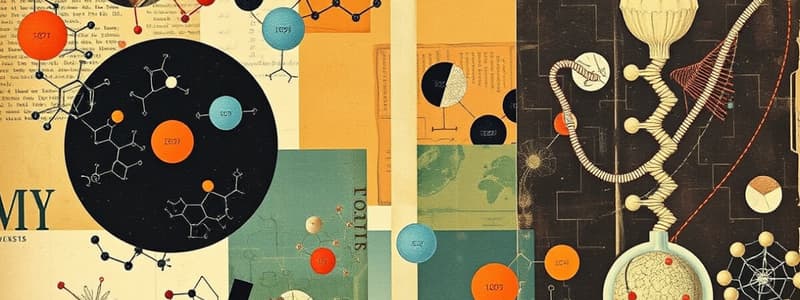Podcast
Questions and Answers
Which molecule is primarily generated for energy production in cells?
Which molecule is primarily generated for energy production in cells?
- ADP
- ATP (correct)
- NADH
- FADH2
What is the role of enzymes in metabolic pathways?
What is the role of enzymes in metabolic pathways?
- To provide energy for reactions
- To act as substrates in reactions
- To catalyze specific reactions (correct)
- To break down waste products
What are the two main types of chemical reactions that take place within cells?
What are the two main types of chemical reactions that take place within cells?
- Hydrolysis and Dehydration
- Condensation and Hydrolysis
- Oxidation and Reduction
- Catabolism and Anabolism (correct)
Which best describes protein synthesis?
Which best describes protein synthesis?
What is signal transduction primarily concerned with?
What is signal transduction primarily concerned with?
Which processes are involved in energy production in living organisms?
Which processes are involved in energy production in living organisms?
How does metabolism relate to disease?
How does metabolism relate to disease?
Which term describes the relationship of enzymes to their substrates?
Which term describes the relationship of enzymes to their substrates?
What role do biochemical systems play in organisms?
What role do biochemical systems play in organisms?
Which of the following techniques is NOT typically used in biochemical analysis?
Which of the following techniques is NOT typically used in biochemical analysis?
What encompasses the process of biochemical adaptation?
What encompasses the process of biochemical adaptation?
Which organelle is commonly referred to as the powerhouse of the cell?
Which organelle is commonly referred to as the powerhouse of the cell?
How does genetic information impact biochemical systems?
How does genetic information impact biochemical systems?
Which component is synthesized in the Endoplasmic Reticulum?
Which component is synthesized in the Endoplasmic Reticulum?
What type of changes are considered long-term adjustments in biochemical adaptation?
What type of changes are considered long-term adjustments in biochemical adaptation?
Which structure contains the genetic material for the cell?
Which structure contains the genetic material for the cell?
What is the primary effect of ionizing radiation on atoms?
What is the primary effect of ionizing radiation on atoms?
What transformation occurs during alpha decay?
What transformation occurs during alpha decay?
Which type of radiation does NOT change the atomic number of an element?
Which type of radiation does NOT change the atomic number of an element?
Which of the following statements about X-rays is TRUE?
Which of the following statements about X-rays is TRUE?
What is the primary process by which radioactive decay occurs?
What is the primary process by which radioactive decay occurs?
What is the main role of mutations in evolution?
What is the main role of mutations in evolution?
Which type of mutation cannot be passed to future generations?
Which type of mutation cannot be passed to future generations?
What causes spontaneous mutations?
What causes spontaneous mutations?
Which phenomenon involves the incorrect pairing of DNA bases?
Which phenomenon involves the incorrect pairing of DNA bases?
How do transposable elements contribute to mutations?
How do transposable elements contribute to mutations?
What is a potential consequence of spontaneous mutations?
What is a potential consequence of spontaneous mutations?
What role does DNA polymerase play during DNA replication?
What role does DNA polymerase play during DNA replication?
Which type of mutation is most likely to arise from mistakes during DNA replication?
Which type of mutation is most likely to arise from mistakes during DNA replication?
What defines somatic mosaicism?
What defines somatic mosaicism?
How can gonadal mosaicism affect offspring?
How can gonadal mosaicism affect offspring?
What is one effect of somatic mosaicism on an individual?
What is one effect of somatic mosaicism on an individual?
Which factor is NOT associated with inducing mosaicism?
Which factor is NOT associated with inducing mosaicism?
What characterizes Pallister-Killian syndrome?
What characterizes Pallister-Killian syndrome?
What is a consequence of ionizing radiation as an exogenous factor in mosaicism?
What is a consequence of ionizing radiation as an exogenous factor in mosaicism?
Which conditions are examples of mosaicism?
Which conditions are examples of mosaicism?
Which of the following best describes the inheritance pattern of somatic mosaicism?
Which of the following best describes the inheritance pattern of somatic mosaicism?
Flashcards are hidden until you start studying
Study Notes
Metabolic Pathways
- Metabolic pathways are chemical processes crucial for cell functions like growth, development, and energy production.
- Catabolism breaks down molecules for energy, whereas anabolism builds complex molecules from simpler ones.
Enzymes and Catalysis
- Enzymes are specialized proteins that catalyze specific reactions by binding to substrates to form enzyme-substrate complexes.
- Enzyme specificity ensures acceleration of particular reactions without affecting others.
Energy Production
- Energy is primarily generated in the form of ATP through processes such as cellular respiration, photosynthesis, and fermentation.
- Energy production is vital for various cellular activities.
Protein Synthesis
- Protein synthesis involves transcription (DNA to mRNA) and translation (mRNA to protein), forming essential macromolecules for cellular functions.
Signal Transduction
- Signal transduction enables cells to respond to external stimuli through a complex network of receptors, enzymes, and signaling molecules.
- This process ensures effective communication within and between cells.
Metabolism and Disease
- Metabolism encompasses all chemical reactions sustaining life, including energy conversion and tissue maintenance.
- Disruptions in metabolic processes can lead to various diseases and health issues.
Genetics and Biochemical System
- Biochemical systems are shaped by genetic information encoded in DNA, affecting metabolic pathways and cellular functions.
Biochemical Analysis Techniques
- Techniques include spectrophotometry, chromatography, electrophoresis, mass spectrometry, and nuclear magnetic resonance spectroscopy for analyzing biological components.
Biochemical Engineering
- Biochemical engineering combines biological science and engineering principles to develop processes and products involving biological systems.
Biochemical Adaptation
- Biochemical adaptation allows organisms to adjust their physiological and metabolic functions according to environmental changes, occurring over short or long time frames.
Cell Organelles
- Organelles are specialized structures within cells performing essential functions, such as the nucleus (genetic material), Golgi apparatus (processing), and mitochondria (energy production).
Types of Mutations
- Somatic mutations occur in non-reproductive cells and may lead to conditions like cancer, affecting the individual but not passed to offspring.
- Germ-line mutations occur in gametes and can be transmitted to future generations, influencing heredity and evolution.
Spontaneous Mutations
- Spontaneous mutations arise naturally from internal processes, like DNA replication errors, leading to random genetic variation crucial for evolution.
Causes of Spontaneous Mutations
- Errors during DNA replication may result in incorrect base pairing or tautomeric shifts that alter genetic information.
- Transposable elements can disrupt normal gene function, contributing to genomic instability.
Mosaicism
- Mosaicism involves an individual having genetically different cells, arising from mutations occurring after fertilization.
- Somatic mosaicism affects body cells without impacting reproductive cells, while gonadal mosaicism occurs in germ cells and can be passed to offspring.
Factors Inducing Mosaicism
- Endogenous factors include mobile elements and DNA polymerase slippage, while exogenous factors involve external agents like UV and ionizing radiation.
Ionizing Radiation
- Ionizing radiation can damage or alter DNA, leading to potential mutations, with sources including X-rays and gamma rays.
Radioactive Decay
- Radioactive decay transforms unstable isotopes into stable ones through alpha decay (emitting protons/neutrons), beta decay (emitting electrons), and gamma decay (emitting electromagnetic radiation).
X-Rays
- X-rays have high energy and short wavelengths, capable of penetrating most objects, used in medical imaging (e.g., CT scans) and security applications.
Studying That Suits You
Use AI to generate personalized quizzes and flashcards to suit your learning preferences.




